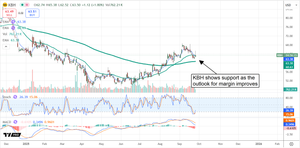
New York, NY – September 25, 2025 – Major U.S. stock indices, including the Dow Jones Industrial Average, the S&P 500, and the Nasdaq Composite, have registered their third consecutive day of declines, signaling a palpable shift in investor sentiment. This extended losing streak follows a period of robust market performance and has prompted investors to meticulously re-evaluate a complex tapestry of economic indicators and evolving market dynamics. The recent pullback underscores growing anxieties about future monetary policy, stretched valuations, and the broader economic outlook, leaving market participants pondering the path ahead.
The current downturn is primarily attributed to a confluence of factors that have collectively dampened investor enthusiasm. Federal Reserve Chair Jerome Powell's recent remarks, emphasizing a cautious approach to future interest rate cuts and noting that equity prices appear "fairly highly valued," served as a significant catalyst. These comments, coupled with stronger-than-expected economic reports suggesting a resilient economy, have reduced the market's anticipation of aggressive rate reductions, thereby putting downward pressure on stock valuations. Furthermore, after a substantial rally that saw indices reach record highs, widespread profit-taking has become evident, particularly in the high-flying technology sector. This re-calibration of asset prices suggests that investors are increasingly scrutinizing company fundamentals against elevated valuations, leading to a period of consolidation and heightened volatility.
Unpacking the Downturn: Fed Caution, Profit-Taking, and Valuation Concerns
The three-day losing streak, observed across the Dow, S&P 500, and Nasdaq, is a direct reflection of several interconnected market forces converging. At its core, the Federal Reserve's cautious stance on monetary policy has been a dominant theme. Chair Powell's statements have effectively tempered expectations for immediate and substantial rate cuts, a prospect that had previously fueled much of the market's upward trajectory. The implication is that the era of "easy money" might be less accessible than previously hoped, increasing the cost of capital for businesses and potentially slowing economic growth.
Simultaneously, the market has witnessed significant profit-taking, especially in sectors that have led the recent bull run. Technology and growth stocks, which often thrive in a low-interest-rate environment, have experienced notable selling pressure as investors lock in gains. This is particularly true for mega-cap technology firms and companies linked to emerging technologies like Artificial Intelligence (AI), which have seen their valuations soar. The current environment suggests a re-evaluation of these high valuations, with market participants questioning the sustainability of such rapid growth in a potentially higher-for-longer interest rate scenario. The modest downturn is, therefore, a re-calibration, as investors digest the implications of a less accommodative monetary policy and assess whether current stock prices accurately reflect future earnings potential.
Navigating the Shifting Tides: Winners and Losers in a Volatile Market
The ongoing market correction is creating distinct winners and losers across various sectors, prompting a strategic re-alignment of investment portfolios. Companies that thrived during the speculative growth phase, particularly those with high valuations and aggressive growth projections, are likely to face continued headwinds. Technology giants and innovative startups, while fundamentally strong, may experience further price adjustments as investors become more risk-averse. For instance, companies like Nvidia (NASDAQ: NVDA), a bellwether for the AI boom, have already seen declines during this period of profit-taking, reflecting concerns over stretched valuations in the growth sector. Other companies reliant on cheap capital for expansion or those with significant debt burdens may also struggle as interest rates remain elevated or rise further.
Conversely, defensive sectors and companies with stable earnings, strong balance sheets, and consistent dividend payouts are poised to become more attractive. Consumer staples, healthcare, utilities, and certain industrial sectors often outperform during periods of market uncertainty and economic slowdowns. Companies within these sectors, such as Johnson & Johnson (NYSE: JNJ) or Procter & Gamble (NYSE: PG), typically offer more predictable cash flows and are less sensitive to economic cycles, making them appealing safe havens for investors seeking stability. Furthermore, value stocks, which are often overlooked during speculative rallies, may find renewed interest as investors pivot towards businesses with solid fundamentals trading at reasonable prices. This shift could also benefit financial institutions (NYSE: JPM), provided the economic slowdown doesn't lead to a significant increase in loan defaults.
Broader Implications: A Market Re-calibration and Economic Crossroads
This extended market downturn is more than just a momentary blip; it signifies a broader re-calibration of asset prices and a potential turning point in the current economic cycle. The market's reaction to the Federal Reserve's cautious tone highlights the sensitive relationship between monetary policy and equity valuations. A "higher-for-longer" interest rate environment could fundamentally alter corporate financing strategies, investment decisions, and ultimately, profitability across industries. This event fits into a broader trend of markets grappling with the transition from an era of ultra-low interest rates to one where capital costs are more significant.
The ripple effects extend beyond direct stock prices. Tighter credit conditions could impact small and medium-sized enterprises (SMEs) more severely, potentially slowing job growth and overall economic expansion. Regulatory bodies will likely be closely monitoring market stability, especially if volatility intensifies, to prevent systemic risks. Historically, periods of high valuation followed by monetary tightening have often led to significant corrections, such as those seen in the dot-com bubble burst or during periods of aggressive Fed rate hikes. While not a direct parallel, the current environment shares similarities, emphasizing the importance of sustainable growth over speculative fervor. This downturn could also force companies to prioritize efficiency and profitability over aggressive expansion, leading to a more disciplined corporate landscape.
What Comes Next: Navigating Uncertainty and Seeking Opportunity
Looking ahead, the market is likely to remain volatile in the short term as investors continue to digest economic data and Federal Reserve communications. The immediate future may see continued pressure on growth stocks and a potential rotation into more defensive or value-oriented sectors. Companies will need to demonstrate resilience, strong earnings growth, and efficient capital management to maintain investor confidence. Strategic pivots, such as focusing on cost control, strengthening balance sheets, and innovating within existing revenue streams, may become crucial for sustained performance.
In the long term, this period of re-calibration could present significant opportunities for discerning investors. Market corrections often prune speculative excesses, allowing high-quality companies with robust fundamentals to emerge stronger. Investors might look for opportunities to acquire undervalued assets or add to their highest-quality holdings at reduced prices. The coming months will be critical for observing how inflation trends, unemployment figures, and consumer spending patterns evolve, as these will heavily influence the Federal Reserve's future policy decisions. A sustained improvement in these indicators, coupled with a clearer path for corporate earnings, could pave the way for a more stable and fundamentally driven market recovery.
A Crucial Juncture: Market Adapts to New Realities
In summary, the three-day losing streak for the Dow, S&P 500, and Nasdaq marks a crucial juncture for the financial markets. It underscores the profound impact of central bank policy and valuation concerns on investor sentiment. Key takeaways include the market's sensitivity to Federal Reserve rhetoric, the ongoing re-evaluation of high-growth stock valuations, and the increasing attractiveness of defensive sectors. The market is moving forward into an environment where capital is no longer as cheap, demanding a more disciplined approach from both companies and investors.
Moving forward, investors should remain vigilant, closely monitoring upcoming economic reports, inflation data, and any further communications from the Federal Reserve. The market's ability to absorb higher interest rates and for corporate earnings to justify current valuations will be paramount. While periods of downturn can be unsettling, they also serve as vital recalibration phases, often laying the groundwork for future sustainable growth. The lasting impact of this period will depend on how quickly economic uncertainties resolve and how effectively companies adapt to the evolving financial landscape, urging investors to prioritize fundamental strength and a diversified, long-term perspective.
This content is intended for informational purposes only and is not financial advice.





